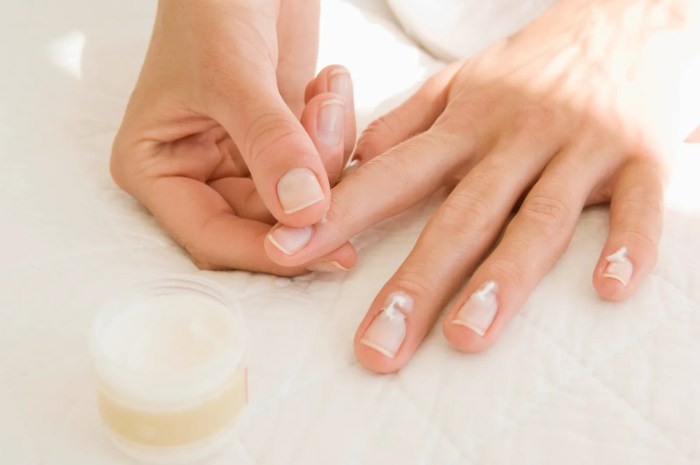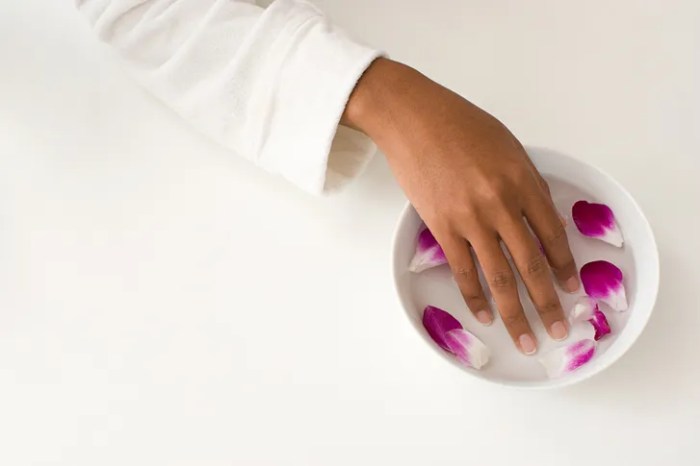How to Take Gel Nail Polish Off at Home
Removing Gel Nail Polish at Home: How To Take Gel Nail Polish Off At Home

Source: allure.com
How to take gel nail polish off at home – Removing gel nail polish at home can be a straightforward process if you follow the right steps and use the appropriate materials. This guide will walk you through the process, from gathering supplies to aftercare, ensuring you achieve a safe and effective removal without damaging your natural nails.
Gathering Supplies
Having the right tools is crucial for a successful gel polish removal. Using high-quality products minimizes the risk of damage to your nails and ensures a smoother process. Cheap acetone, for example, can be harsh and dry out your nails, leading to breakage and peeling. Similarly, using dull or rough files can scratch your nails.
| Acetone Brand | Features | Price Range | User Reviews (General Sentiment) |
|---|---|---|---|
| Brand A | Pure acetone, fast-drying | $5-$10 | Mostly positive; some report strong odor |
| Brand B | Acetone with added moisturizers | $8-$15 | Positive; less harsh on nails |
| Brand C | Acetone with essential oils | $12-$20 | Positive; pleasant scent, but may not dry as fast |
The table above provides a general comparison; actual prices and reviews may vary based on location and retailer.
- 100% Acetone: The primary solvent for dissolving gel polish.
- Cotton Pads: Soft and absorbent for soaking the nails.
- Aluminum Foil: To secure the cotton pads and keep the acetone in contact with the nails.
- Nail File (fine grit): To gently file the top layer of the gel polish, creating micro-pores for better acetone penetration. Avoid using a coarse grit file, as this can damage the nail.
- Cuticle Pusher (optional): To gently push back cuticles, preventing them from becoming damaged during the removal process.
- Nail Buffer (optional): To smooth the nail surface after removal.
- Cuticle Oil: To moisturize and condition the cuticles and nails after removal.
- Hand Cream: To moisturize the hands after the removal process.
- E-file (optional, for experienced users only): A specialized tool for faster and more precise gel polish removal.
Preparing the Nails

Source: allure.com
Proper nail preparation is essential to prevent damage and ensure effective gel polish removal. This involves carefully filing the top layer of the gel polish to create tiny fissures that allow the acetone to penetrate more effectively. Protecting the surrounding skin is also crucial to prevent irritation from the acetone.
- Gently file the top shiny layer of the gel polish with a fine-grit nail file. Avoid aggressive filing, which can damage your natural nails. The goal is to create a slightly rough surface, not to remove all of the gel.
- Apply a thin layer of cuticle oil or petroleum jelly around the nail bed to protect your skin from the acetone.
- Ensure your nails are clean and free from any loose debris before proceeding to the acetone soak.
Acetone Soak Method
The acetone soak method is a common and generally safe method for removing gel nail polish at home. The process involves soaking cotton pads saturated with acetone on the nails, covered with aluminum foil to maintain moisture and maximize the effectiveness of the acetone.
- Saturate cotton pads generously with 100% acetone.
- Place a saturated cotton pad on each nail.
- Wrap each fingertip tightly with a small piece of aluminum foil to secure the cotton pad in place.
- Let the acetone soak for 10-15 minutes. For very stubborn gel polish, you may need to leave it on for longer (up to 20 minutes), but monitor closely to avoid over-exposure to acetone.
- After the soaking time, gently remove the foil and cotton pads.
- Gently push or scrape off the softened gel polish with a cuticle pusher or orangewood stick. Avoid pulling or ripping the polish, which can damage your nails.
- If some gel polish remains, repeat the soaking process for a shorter period.
E-File Method (for experienced users only)
The e-file method offers a faster removal process but requires experience and caution to avoid damaging the natural nail. Improper use can lead to significant nail damage. This method should only be attempted by individuals with prior experience using an e-file.
Safety Precautions: Always use a low-speed setting and a fine-grit bit. Maintain a light touch and avoid excessive pressure. Keep the bit moving constantly to prevent overheating and damage. Consult professional tutorials before attempting this method.
The e-file method is faster than the acetone soak method, but it carries a higher risk of nail damage if not performed correctly. The acetone soak method is generally safer for beginners.
Aftercare and Nail Care, How to take gel nail polish off at home

Source: heypumpkin.com
Post-removal care is crucial for maintaining the health and strength of your nails. Moisturizing is essential to replenish hydration lost during the removal process, and proper cuticle care helps prevent infection and promotes nail growth.
- Apply cuticle oil to moisturize and nourish the cuticles and nails.
- Use a rich hand cream to hydrate the skin around your nails.
- Avoid harsh chemicals and prolonged exposure to water.
- Give your nails a break from polish for a while to allow them to recover.
- Cuticle oil
- Hand cream
- Nail strengthener
Troubleshooting Common Issues
Several issues can arise during gel polish removal. Understanding these problems and their solutions can help you achieve a successful removal without damaging your nails.
| Problem | Cause | Solution |
|---|---|---|
| Stubborn polish | Thick application, low-quality polish | Increase soaking time, use a higher concentration of acetone |
| Skin irritation | Acetone contact with skin | Apply a barrier cream around the nails before soaking |
| Nail damage | Aggressive filing, improper e-file use | Use a fine-grit file, practice proper e-file technique |
Illustrative Examples
Imagine the gel polish initially appearing smooth and glossy. After filing, a slightly roughened surface is visible, allowing better acetone penetration. During the soak, the gel polish gradually softens, changing from a hard, glossy texture to a pliable, almost rubbery consistency. Upon removal, the nail underneath might appear slightly duller than usual, but it should be intact and undamaged if the process was done correctly.
Damaged nails might exhibit peeling, thinness, or ridges. Healthy nails will appear smooth, even, and have a healthy pink hue. A damaged nail might appear brittle, discolored, or have visible cracks.
FAQ Guide
Can I use regular nail polish remover instead of acetone?
No, regular nail polish remover is not strong enough to dissolve gel polish. Acetone is necessary for effective removal.
How often should I remove my gel polish?
It’s generally recommended to remove gel polish every 2-3 weeks to prevent potential damage to your natural nails.
What should I do if my skin gets irritated?
If you experience skin irritation, stop the process immediately, wash the area thoroughly, and apply a soothing moisturizer. If irritation persists, consult a dermatologist.
Removing gel nail polish at home requires careful soaking and gentle scraping. Before you begin, however, it’s wise to check the expiration date of your nail polish remover; knowing how long should you keep nail polish can prevent using expired products that might damage your nails. Using a fresh remover ensures a cleaner and safer removal process for your gel manicure.
Remember to always moisturize your nails afterward.
My gel polish is extremely stubborn; what should I do?
Try reapplying the acetone-soaked cotton pads and foil, extending the soaking time. If it still doesn’t budge, consider using an e-file (if experienced) or seeking professional help.















